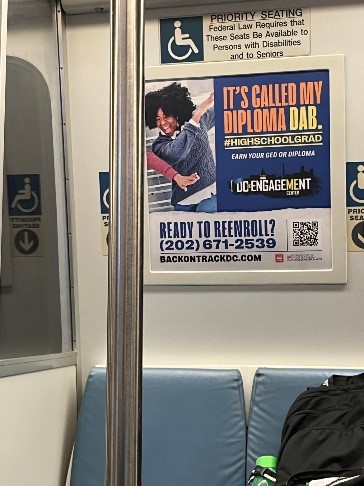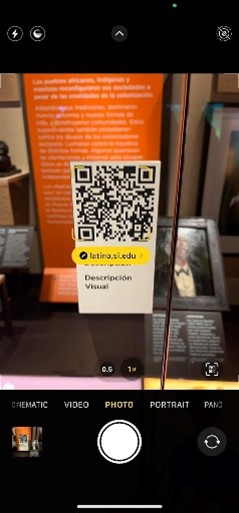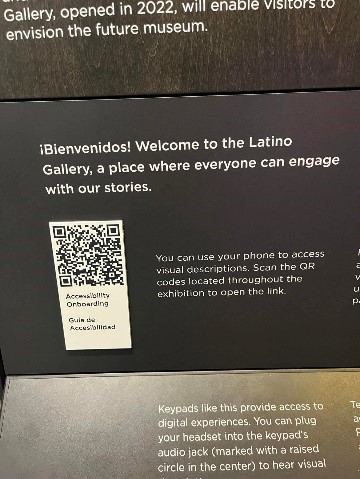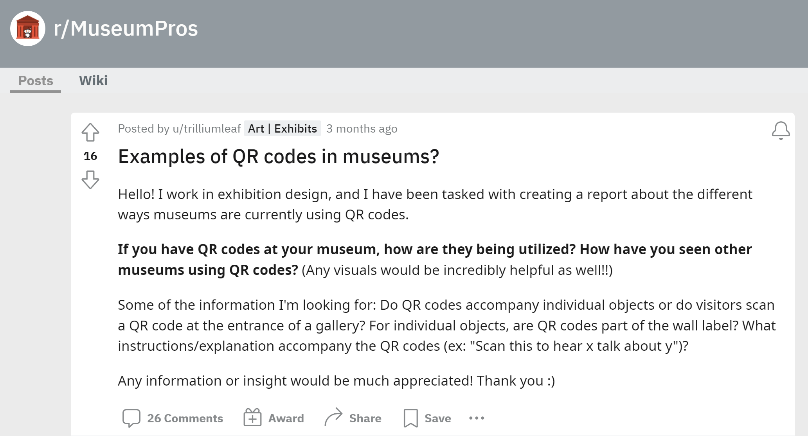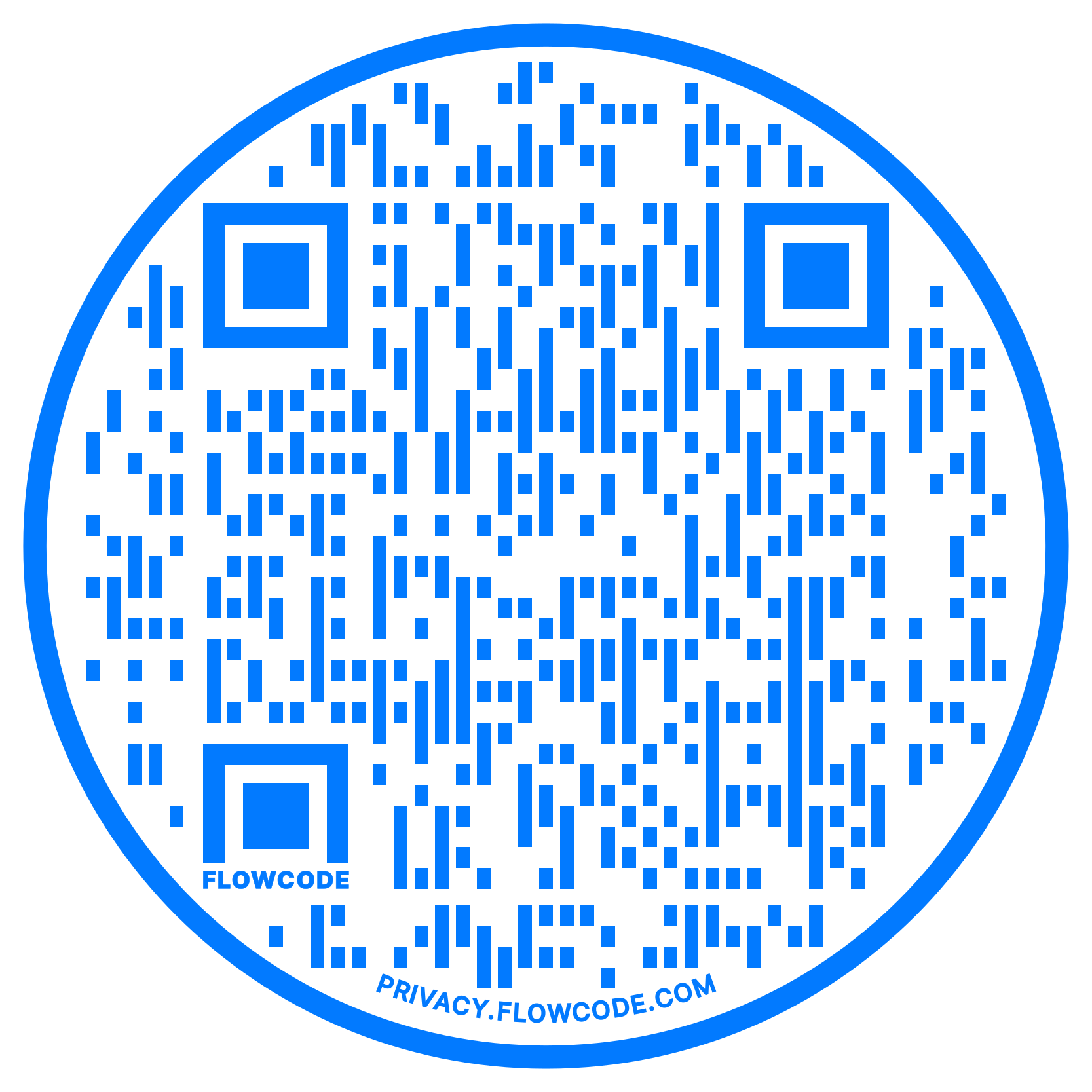XII. QR Codes and Museums: More Potential Than Meets the Eye?
- Anissa Santos, The George Washington University
In 2022, most people are relatively cognizant of the ever-present black and white square that sits in the bottom corner of a variety of advertisements on streets, magazines, and public transport. The infamous (or rather ordinary) Quick Response code (QR for short). Now, museum visitors can often expect to see QR codes in lieu of museum maps, or if there is a map, a QR code at the bottom that leads them to certain content. Whereas ads utilize QR codes as a method to link users with their product page, museums (at least Western ones) have been trying to grapple with how to properly implement this technology into their museums since at least 2009.1 Countries, like Japan, were experimenting with and implementing audiovisual guides in their museum spaces even in 2007, but for the scope of this piece, we will mostly be focusing on America and the Western hemisphere.2
While the replacement of a physical map with a QR code is an arguably “uninspired” tactic of implementing technology, museums have also been experimenting with utilizing these phone camera recognition systems to supply more information within their exhibit spaces. Take the integration of the Hirshhorn Eye (Hi) in the Smithsonian’s Hirshhorn Museum as an example.3 This smartphone-based AR (Augmented Reality)-recognition feature is meant to act as a “revolutionary in-gallery art guide” that allows visitors to directly scan certain artworks with their personal phone camera to learn more about them.4 When I initially tried Hi during my first visit to the Hirshhorn, I became increasingly irritated as I tried to juggle my QR-code accessed museum map and simultaneously decipher how to work Hi. In the end, I was disconnected from my museum experience only to receive an extended object label or video. This experience, and my increased interaction with QR codes in and out of museums, made me begin to question if Hi’s implementation was the problem rather than merely me. Though not precisely a QR code, the lessons brought about by Hi, an Augmented Reality-based example, in 2022 are similar to the questions that have been constantly interrogated by museum experts and goers about the usage of QR codes since its early integration in Western museums. What do they truly add to the visitor experience (if any)? What does it mean to be successful?
We are currently in an age of technological acceleration where newer, shinier technologies and experiences are being privileged by museums and inevitably expected by their visitors. Has the QR code run its course? Should it yield to Augmented Reality (AR) tools and other technologies, as seen in the Hirshhorn, or is this a time of transformation? Not only has it been projected that one billion smartphones worldwide would now be able to automatically access QR codes, but the current pandemic, new technology, and overall push for a variety of museum experiences present QR codes with fruitful possibilities and potential for success.5 Success, for this paper, means implementing QR codes in a way that enhances the museum’s mission and visitor experience rather than being used for the sake of having it. With this in mind, how do we ensure that the QR code will live up to its potential and allow every visitor to truly “connect” to our museums?
A Hopeful (Turned Pessimistic) Industry
In the early 2010s, the National Museum of Scotland began implementing QR codes in their exhibition spaces in hopes to, in the words of Principle Curator of Communications, Alice Taubman,
not only give visitors more information about objects and stories, but also involve our visitors in adding their own responses to the objects, whether personal reflections or additional resources to let others find out even more.6
Though their process was well documented, the NMS was not the only institution that was excited about the prospects of QR code implementation in the field. The usage of QR codes has been long tried and discussed by professionals in and out of museums. The Mattress Factory in Philadelphia began using them to refer visitors to extra exhibit content via a scanner app in 2009.7 From their initial implementation in museums, questions about the potential, and consequent challenges of QR codes have been discussed extensively by museum professionals. Keep in mind that the essentially universal access to QR code scanning technology mentioned earlier did not exist in the early 2010s.8 Questions, speculations, and concerns were rising over the possibilities of QR codes, but so were frustrations with the lack of resources and technological literacy among the population at the time. Seb Chan said it best in his early 2009 article about QR codes,
If these URLs are just going to send me to a website that isn’t tailored for my context and device then they are going to be just a gimmick. But if, on the other hand, they can deliver timely, mobile-formatted content to me that addressed my specific ‘need’ at the time then they might just work.9
Does the first part sound familiar? People come to museums for a variety of reasons, however, the one thing they have in common is that they are choosing to go to an in-person experience. Chan’s concerns over the misuse of QR codes were, and still are, completely valid. Gimmicks are fads. While they may seem amusing, their lifespan is short because of the reason that they do not hold sustainable value or use. Branching from his argument, if these codes are merely going to act as extended object labels, physical label replacements, or digital museum maps (with no alternatives), then of course museums would be hesitant to invest in them. Even more pressing was the growing concern of whether visitors even wanted to or knew how to interact with a QR code.
As we move towards the mid-2010s, we see more and more articles and forums (both in and out of museums) show an increased questioning of the effectiveness of QR codes. Not long after the QR code’s uptake began rising in the US, a company strategist, Eric Holtzclaw released an article that stressed that our world was not ready for QR codes.10 The most striking fact of the short article was that “97% of consumers don’t know what a QR Code is.”11 While there is an notable lack of transparency regarding who was surveyed to produce such a percentage, this article and statistic represent probably one of the largest concerns surrounding QR codes – use. Though not a museum professional, Holtzclaw was not alone in his denouncement and ridicule of this technology. Many museum-related sites, and professionals in business and tech, would proceed to claim that the QR code was “dying” in general.12 The main issue was simply that people were not using them.
Improvements and Success Stories
Thankfully, some of these concerns soon lost their relevancy. Specifically, one of the primary issues of implementing QR codes, the technological barrier of downloading a scanner app, ended in 2017 for iPhone and 2019 for Android users with the integration of QR scanners in their phones’ cameras.13 Such advances helped break down the technological and convenience barriers that formerly impeded visitor experience and the use of an application. Furthermore, many of the aforementioned critiques surrounding the QR code appeared to scapegoat the technology in question rather than accept responsibility for how we have chosen to implement the technology. After all, technology is a tool, and we as users, choose how to employ such a tool. Design issues such as the size of codes, placement, and even visitor-friendly instructions could help alleviate many issues such as uptake, aesthetics, and clarity (to name a few). If any technology is being implemented and is not as successful or used as intended, the next move should be to see how they can swim in their new environment, rather than letting them drown. Technology and interactivity are all about trial and error, as documented by the Brooklyn Museum with their QR codes back in 2011, and that mindset is one that transcends any period of technological development.14 The reason we still have QR codes in museums, and the reason I am writing this piece, is because there have been many cases where museums have been able to apply such strategies to tap into their usefulness, especially in light of the COVID-19 pandemic.
Shifting Gears - QR Codes in the Present
Prior to the pandemic, museums were developing efficient and meaningful ways to implement QR codes into their institutions. In the Reddit thread r/MuseumPros, a question was posted asking for “Examples of QR codes in museums?”15 The post received various comments from users who both worked at and visited museums. While there were comments describing QR codes as being extended object labels, which is a more standardized use of QR codes, there were plenty more examples of museums that demonstrated an understanding of QR codes’ abilities to aid their mission as a museum.16 U/textmarie described how their museum used QR codes to provide visitors with the choice to listen to oral histories of survivors from an abusive orphanage, a strategy which also allowed the museum to add content warnings.17 Other users commented on QR codes being used for self-guided audio tours, collecting visitor responses for art, language accessibility, and even ticketing.18 My personal favorite comment was from u/FluffyBunnyRemi who experienced the Q?rious exhibit at the Smithsonian Museum of Natural History where visitors could take objects with QR codes posted on them to a computer terminal to pull up a file on the object.19
It’s a really cool way to encourage folks to learn more about objects, without having to use object labels, especially considering there’s hundreds and hundreds of objects, in this exhibit, and trying to include label space for all of them would be absolutely impossible.
These examples demonstrate what it means to have a crucial understanding of your visitors’ needs. Whether if it’s for logistical reasons, accessibility, or experience and immersion, QR codes are meant to be helpful to their user. While everyone may not choose to use QR codes, the other essential part of their function is their contribution to visitor choice. While the Smithsonian Museum of Natural History intentionally included QR codes as a tool for their experience, the other examples aimed to enhance the visitor experience by providing options. Museums are nonlinear experiences, and the more museums embrace customizability in visitor learning and navigation, the more crucial QR codes become because of their affordability and flexibility.
These examples are not the only positive examples of QR code implementation, nor will they be the last. Much of this article has so far been focused on sharing the semi-pitfalls of QR codes in exhibit spaces, but despite the previously mentioned concerns, QR codes are still, if not more, relevant. As we move towards the present day, museums begin to move beyond integrating QR codes as part of their in-gallery object experience to use them for promotional activities for events, social media, and surveys.20 Without the original technological barrier of downloading QR scanning applications on visitors’ devices, museums at this stage (in theory) only need to design with intent in order for their QR codes to be “successful.” If a museum implements a QR code for the sake of being technologically savvy or relevant, then it is merely going to fall as, what Seb Chan also feared, a gimmick.21 However, if a museum implements their QR codes in a meaningful way for their particular institution, and is also willing to continue to update and improve them, then that would lead to more positive examples and experiences, like the ones these Redditors recalled.
More Present-Day Examples!
The following cases are just a few more examples of museums that demonstrate this recent, increased understanding of the potential effectiveness of the QR code. In the Fall of 2019, the Whitney Museum of American Art launched a web-based museum guide to help aid in the accessibility of their in-gallery experience.22 To help users easily find and access the guide, they turned to QR codes. Not only did the team at the Whitney conduct the proper research to understand why QR codes would be the most effective tool for them, but they intentionally created slightly different codes in order to track and see where visitors were most likely to access their guides.23 With the help of QR codes, around one-fifth of their total guests accessed their codes over a 7-month span.24 In 2022, The Louvre Fantastic exhibit in Illinois created an app that corresponded with QR codes placed around the exhibit to create an experience for guests that would dismantle the traditional art museum experience.25 According to the Art Curator, Joan Carrubba,
The idea behind the QR codes is that you can scan it, and either you hear more about the piece or there’s a fun, interactive element that comes along with it.
Media and experience companies contracted by museums have even developed suggestions to guide museums on how to utilize QR codes to promote fun, accessible, and of course, inexpensive experiences such as scavenger hunts and videos of restoration processes.26 Without the technological constraints, museums have been able to reimagine the QR code’s place in their museums and further demonstrate that technology is only as good as we choose to utilize it.
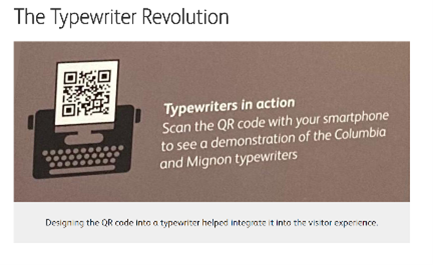
Cycling back to the beginning of this piece, The National Museum of Scotland, which first began utilizing their QR codes in 2010, recently released an article addressing the state of QR codes in 2022.27 Spoiler alert, it is rather positive. Since their first run, NMS has proceeded to continue using QR codes in their exhibits, not only to aid in the in-gallery experience but also to collect data on their usefulness. While their Galloway Hoard exhibition used QR codes to show 3D models of some of the objects which were unable to be viewed in close proximity due to COVID, their Typewriter Revolution exhibit’s QR codes showed videos of typewriters in action and were even designed to mimic the look of a typewriter.28 This museum’s continued experimentation with QR codes allowed them to rebuttal many of the early skepticism towards the codes and even provide some advice for the entire process of implementing them – from design to security.29 Technology in museums should be treated as collections. Similar to how collection objects are selected for museums based on appropriateness and maintenance, technology should be treated with the same standards. Not only should they be used on a case-by-case basis, but museums should also remain cognizant that they are meant to be monitored and constantly renovated and improved based on audience interaction. What is so special about QR codes is their ability to be altered to fit changing visitor needs. This factor is especially crucial when considering our existence in a semi-post-COVID world.
QR Codes in the Post-COVID World
The onset of the COVID-19 pandemic has also propelled the resurgence of QR codes in our general society, causing museum experts to re-evaluate their use. COVID-19 led to many industries and services redefining their experiences and distance protocols. As examined by the design firm Mather & Co, QR codes have been rising in the public sector making it an even more opportune time to continue their use in exhibition spaces.30 Not only is this increased societal reliance on QR codes lowering barriers to use, but this means that QR codes in museums may find new types of users who may have not been interested in them prior to the pandemic. In July of 2021, Statista reported that roughly a third of their US and UK respondents had used a QR code “within the past week.”31 This indicates that a substantial number of Americans now have a newfound sense of familiarity with QR codes. Increased familiarity means we could expand the idea of QR codes as not only “COVID friendly,” but also on par with guest engagement and accessibility. BYOD, or Bring Your Own Device, features are already being experimented with in museums to allow those with vision impairments to be directed to informational object pages that are designed to cater to their needs.32 QR codes are not merely about bringing a “unique” or “innovative” experience, but also breaking down barriers of access that were not feasible in museum spaces before. The pandemic has opened the doors for further discussion on QR codes as a necessity rather than an additive. When accessibility comes into the equation, though it should always be included, then it is no longer about the number of users, but whether the QR codes are allowing every visitor the possibility of an enriching experience.
Looking Beyond
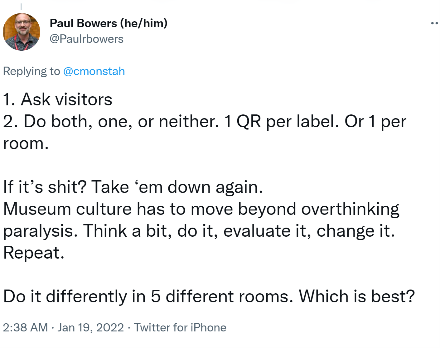
QR codes are not going anywhere nor should they. The reason the Hirshhorn Eye was unsuccessful for my visit was largely due to unclear directions and semi-personal issues with the scanning. Though an overall frustrating experience, would I say this is the death of AR? No. It was a merely faulty, but fixable, case of implementation and design. As museum professionals, we are familiar with the idea of evaluation. An important step of such a practice is understanding A: what went wrong and B: how we can improve things. People still have gripes with QR codes in 2022 but technology, and QR codes specifically, can be revamped and re-implemented to mitigate complaints.33 As we look to the future of QR codes to encompass more AR (Augmented Reality) features and offer more opportunities for immersion, gamification, and accessibility (just to name a few), it seems the QR code has a long life ahead of it.34 No longer are there concerns about downloading QR code scanners, but rather in seeing how we can push the QR code beyond its limits to help provide impactful experiences in any type or size of museum. As long as museums pay close consideration to the who, how, and why factors when they are choosing to implement QR codes, QR codes will not die. In fact, they are just getting started.
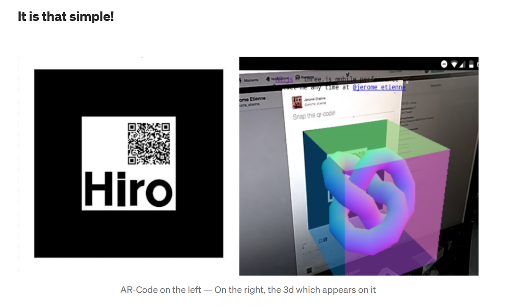
Thank you for making it to the end! I would love to connect with anyone who comes across my piece. Open the camera on your phone and point it towards the QR code to scan.
Notes
-
Jeffery Inscho “Mattress Factory | Art You Can Get Into: QR Codes : A Visitor’s Resource Guide,” Mattress Factory | Art You Can Get Into (blog), April 3, 2009, http://artyoucangetinto.blogspot.com/2009/04/qr-codes-visitors-resource-guide.html. ↩︎
-
Hiroyuki Arita-Kikutani and Kazuhiro Sakamoto, “Using a Mobile Phone Tour to Visit the Ueno Zoological Gardens and the National Science Museum in Tokyo, Japan,” Journal of Museum Education 32, no. 1 (March 1, 2007): 35–45, https://doi.org/10.1080/10598650.2007.11510556. ↩︎
-
“Hirshhorn Eye,” Hirshhorn Museum and Sculpture Garden | Smithsonian, Hirshhorn Museum and Sculpture Garden, accessed Sseptember 11, 2022, https://hirshhorn.si.edu/hi/. ↩︎
-
“Hirshhorn Eye.” ↩︎
-
Rebecca Hardy Wombell, “QR Codes Are Experiencing a Resurgence but How Can They Benefit Museums?,” MuseumNext, February 18, 2022, https://www.museumnext.com/article/qr-codes-are-experiencing-a-resurgence-but-how-can-they-benefit-museums/. ↩︎
-
Michael MacLeod, “Museum Collection Gets QR Codes,” The Guardian, April 14, 2011, https://www.theguardian.com/edinburgh/2011/apr/14/edinburgh-national-museum-scotland-qr-codes. ↩︎
-
Jeffery Inscho, “Mattress Factory | Art You Can Get Into: QR Codes : A Visitor’s Resource Guide.” ↩︎
-
Rebecca Hardy Wombell, “QR Codes Are Experiencing a Resurgence but How Can They Benefit Museums?” ↩︎
-
Seb Chan, “QR Codes in the Museum – Problems and Opportunities with Extended Object Labels,” Fresh & New(Er) (blog), March 5, 2009, https://www.freshandnew.org/2009/03/qr-codes-in-the-museum-problems-and-opportunities-with-extended-object-labels/. ↩︎
-
Eric Holtzclaw, “QR Codes? Don’t Bother. 5 Reasons,” Inc.com, July 3, 2012, https://www.inc.com/eric-v-holtzclaw/qr-codes-dont-bother-five-reasons.html. ↩︎
-
Holtzclaw, “QR codes? Don’t Bother. 5 Reasons.” ↩︎
-
“Life & Death of QR Codes in Museums,” Cuseum, October 28, 2016, https://cuseum.com/blog/life-death-of-qr-codes-in-museums. ; Aaron Strout, “The Death Of The QR Code,” MarTech, April 4, 2013, https://martech.org/the-death-of-the-qr-code/. ↩︎
-
Sneh Ratna Choudhary, “How to Scan QR Codes with Android Phones without an App,” Beaconstac (blog), May 27, 2022, https://blog.beaconstac.com/2019/03/how-to-scan-qr-codes-with-android-phones/. ↩︎
-
Shelley Bernstein, “QR Code Conundrum,” BKM TECH (blog), October 20, 2011, https://www.brooklynmuseum.org/community/blogosphere/2011/10/20/qr-code-conundrum/. ↩︎
-
trilliumleaf, “Examples of QR Codes in Museums?,” Reddit Post, R/MuseumPros, August 18, 2022, www.reddit.com/r/MuseumPros/comments/wrrtre/examples_of_qr_codes_in_museums/. ↩︎
-
trilliumleaf, “Examples of QR Codes in Museums?.” ↩︎
-
trilliumleaf, “Examples of QR Codes in Museums?.” ↩︎
-
trilliumleaf, “Examples of QR Codes in Museums?.” ↩︎
-
trilliumleaf, “Examples of QR Codes in Museums?.” ↩︎
-
Apporva Hedge, “QR Codes for Museums: Improve Visitor Experience,” Beconstac | Blog (blog), June 15, 2022, https://blog.beaconstac.com/2021/03/qr-codes-for-museums/. ↩︎
-
Seb Chan, “QR Codes in the Museum – Problems and Opportunities with Extended Object Labels.” ↩︎
-
Sofie Andersen, “The Whitney’s Mobile Guide,” Whitney Digital (blog), February 24, 2019, https://medium.com/whitney-digital/the-whitneys-mobile-guide-191672709628. ↩︎
-
Colin Brooks, “QR Codes: Alive and Well in the Museum?,” Whitney Digital (blog), September 17, 2019, https://medium.com/whitney-digital/qr-codes-alive-and-well-47115abd234. ↩︎
-
Colin Brooks, “QR Codes: Alive and Well in the Museum?.” ↩︎
-
“Explore the Louvre Museum at This New Interactive Exhibition in Oakbrook,” 6abc Philadelphia, August 31, 2022, https://6abc.com/louvre-fantastique-museum-immersive-experience-oakbrook/12183624/. ↩︎
-
Katie Evans, “Four Inexpensive Ways to Use QR Codes to Engage Your Patrons,” American Alliance of Museums (blog), September 1, 2022, https://www.aam-us.org/2022/09/01/four-inexpensive-ways-to-use-qr-codes-to-engage-your-patrons/. ↩︎
-
Adam Coulson, “QR Codes in Museums – Worth the Effort?,” National Museums Scotland Blog (blog), July 19, 2022, https://blog.nms.ac.uk/2022/07/19/qr-codes-in-museums-worth-the-effort/. ↩︎
-
Adam Coulson, “QR Codes in Museums – Worth the Effort?.” ↩︎
-
Adam Coulson, “QR Codes in Museums – Worth the Effort?.” ↩︎
-
Kelsey Mulvey, “How Covid-19 Could Influence the Use of QR Codes in Museums and Exhibitions,” LinkedIn, August 12, 2021, https://www.linkedin.com/pulse/how-covid-19-could-influence-use-qr-codes-museums-kelsey-mulvey/?trk=read_related_article-card_title. ↩︎
-
Rebecca Hardy Wombell, “QR Codes Are Experiencing a Resurgence but How Can They Benefit Museums?” ↩︎
-
Cheryl Fogle-Hatch. ““Bring Your Own Device” (BYOD) programming facilitates accessibility for people who are blind or have low vision.” MW20: MW 2020. Published January 15, 2020. Consulted October 24, 2022. https://mw20.museweb.net/paper/bring-your-own-device-byod-programming-facilitates-accessibility-for-people-who-are-blind-or-have-low-vision/. ↩︎
-
Caroline A. Miranda, “QR Codes in Museums Can Be a Blessing. They Are Also a Curse,” Los Angeles Times, January 22, 2022, https://www.latimes.com/entertainment-arts/newsletter/2022-01-22/essential-arts-qr-codes-in-museums-blessing-and-curse-essential-arts. ↩︎
-
Yashika Tangri, “QR Code in Augmented Reality: All-New Way to See the Real-World,” Scanova Blog (blog), February 3, 2021, https://scanova.io/blog/augmented-reality-qr-code/. ↩︎
